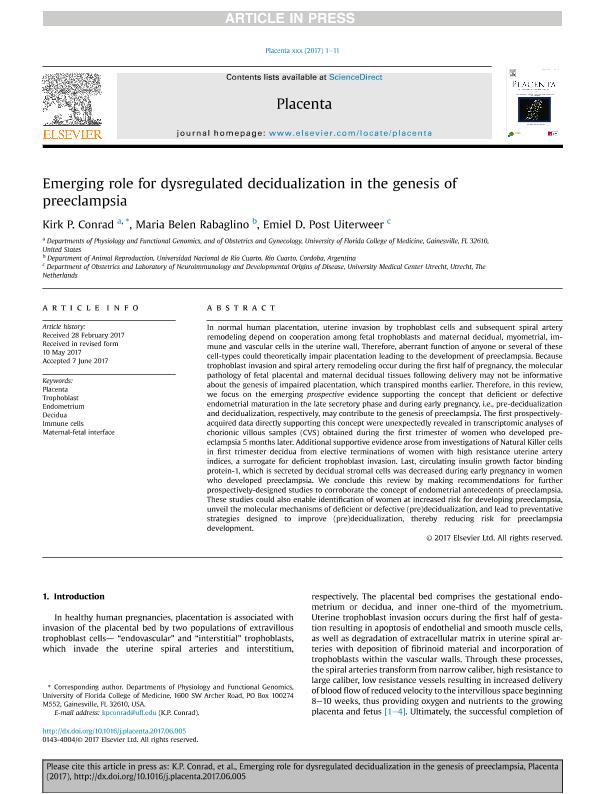Mostrar el registro sencillo del ítem
dc.contributor.author
Conrad, Kirk P.
dc.contributor.author
Rabaglino, Maria Belen

dc.contributor.author
Post Uiterweer, Emiel D.
dc.date.available
2019-04-24T18:44:05Z
dc.date.issued
2017-12
dc.identifier.citation
Conrad, Kirk P.; Rabaglino, Maria Belen; Post Uiterweer, Emiel D.; Emerging role for dysregulated decidualization in the genesis of preeclampsia; W B Saunders Co Ltd; Placenta; 12-2017
dc.identifier.issn
0143-4004
dc.identifier.uri
http://hdl.handle.net/11336/74944
dc.description.abstract
In normal human placentation, uterine invasion by trophoblast cells and subsequent spiral artery remodeling depend on cooperation among fetal trophoblasts and maternal decidual, myometrial, immune and vascular cells in the uterine wall. Therefore, aberrant function of anyone or several of these cell-types could theoretically impair placentation leading to the development of preeclampsia. Because trophoblast invasion and spiral artery remodeling occur during the first half of pregnancy, the molecular pathology of fetal placental and maternal decidual tissues following delivery may not be informative about the genesis of impaired placentation, which transpired months earlier. Therefore, in this review, we focus on the emerging prospective evidence supporting the concept that deficient or defective endometrial maturation in the late secretory phase and during early pregnancy, i.e., pre-decidualization and decidualization, respectively, may contribute to the genesis of preeclampsia. The first prospectively-acquired data directly supporting this concept were unexpectedly revealed in transcriptomic analyses of chorionic villous samples (CVS) obtained during the first trimester of women who developed preeclampsia 5 months later. Additional supportive evidence arose from investigations of Natural Killer cells in first trimester decidua from elective terminations of women with high resistance uterine artery indices, a surrogate for deficient trophoblast invasion. Last, circulating insulin growth factor binding protein-1, which is secreted by decidual stromal cells was decreased during early pregnancy in women who developed preeclampsia. We conclude this review by making recommendations for further prospectively-designed studies to corroborate the concept of endometrial antecedents of preeclampsia. These studies could also enable identification of women at increased risk for developing preeclampsia, unveil the molecular mechanisms of deficient or defective (pre)decidualization, and lead to preventative strategies designed to improve (pre)decidualization, thereby reducing risk for preeclampsia development.
dc.format
application/pdf
dc.language.iso
eng
dc.publisher
W B Saunders Co Ltd

dc.rights
info:eu-repo/semantics/openAccess
dc.rights.uri
https://creativecommons.org/licenses/by-nc-sa/2.5/ar/
dc.subject
Decidua
dc.subject
Endometrium
dc.subject
Immune Cells
dc.subject
Maternal-Fetal Interface
dc.subject
Placenta
dc.subject
Trophoblast
dc.subject.classification
Medicina Critica y de Emergencia

dc.subject.classification
Medicina Clínica

dc.subject.classification
CIENCIAS MÉDICAS Y DE LA SALUD

dc.title
Emerging role for dysregulated decidualization in the genesis of preeclampsia
dc.type
info:eu-repo/semantics/article
dc.type
info:ar-repo/semantics/artículo
dc.type
info:eu-repo/semantics/publishedVersion
dc.date.updated
2019-04-16T20:41:39Z
dc.journal.pais
Reino Unido

dc.journal.ciudad
Londres
dc.description.fil
Fil: Conrad, Kirk P.. University of Florida; Estados Unidos
dc.description.fil
Fil: Rabaglino, Maria Belen. Universidad Nacional de Río Cuarto; Argentina. Provincia de Córdoba. Ministerio de Ciencia y Técnica. Centro de Excelencia en Productos y Procesos de Córdoba; Argentina. Consejo Nacional de Investigaciones Científicas y Técnicas. Centro Científico Tecnológico Conicet - Córdoba; Argentina
dc.description.fil
Fil: Post Uiterweer, Emiel D.. University of Utrecht; Países Bajos
dc.journal.title
Placenta

dc.relation.alternativeid
info:eu-repo/semantics/altIdentifier/doi/http://dx.doi.org/10.1016/j.placenta.2017.06.005
dc.relation.alternativeid
info:eu-repo/semantics/altIdentifier/url/https://www.sciencedirect.com/science/article/abs/pii/S0143400417302898
Archivos asociados
